Technics EAH-AZ100 vs Sony WF-1000XM5: which premium wireless earbuds are better?
Can Technics beat the class-leading Sony XM5?
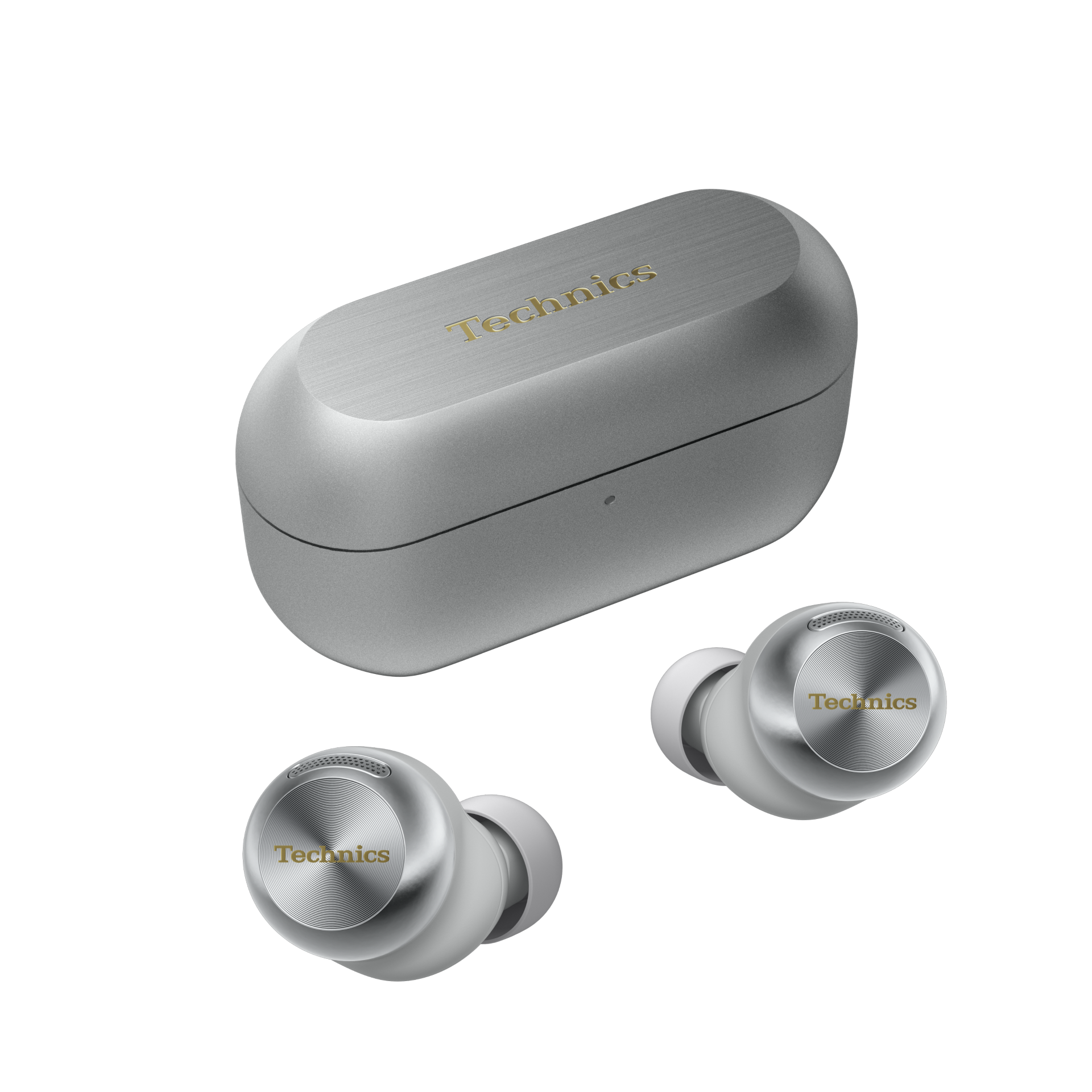
Bluetooth: 5.3
Codec support: AAC, SBC, LDAC
Noise cancelling: Yes
Battery Life: 10 hours (single charge), 28 hours with case (ANC on)
Finishes: x2 (black, silver)
Weight: 5.9g per bud
The Technics AZ100 is a likeable, comfortable pair of premium earbuds that offer customisable features, effective ANC and excellent sound quality.
For
- Superb levels of detail and clarity
- Expressive, engaging and open presentation
- Excellent noise-cancelling
- Comfortable design and fit
- Ample customisable features
Against
- Voice Focus AI call feature makes us sound robotic
- Cheaper Sony XM5 is more rhythmically engaging and punchy
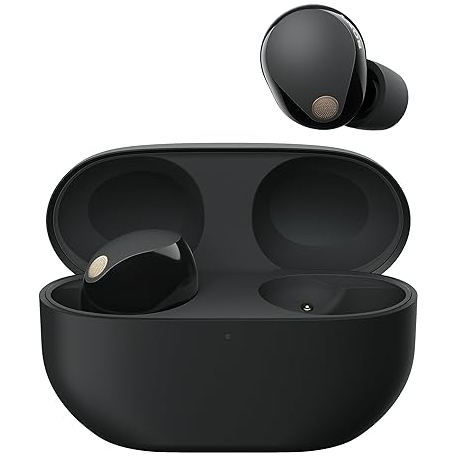
Bluetooth: 5.3
Codec support: AAC, SBC, LDAC
Noise cancelling: Yes
Battery Life: 8 hours (single charge), 24 hours with case (ANC on)
Finishes: x2 (black, silver)
Weight: 5.9g per bud
The Award-winning WF-1000XM5 still impresses with musically engaging, rhythmically driven sound and great features for a knockdown price.
For
- Impressive detail and clarity
- Top-notch musicality and timing
- Premium-feeling design
- Voices sound natural over calls
- Intuitive features
Against
- Technics offers a greater degree of detail, clarity and openness
- Could feel more secure
- Battery life can be beaten these days
Sony's WF-1000XM5 have been our favourite wireless earbuds ever since they launched in 2023, with their stunning sound quality standing head and shoulders above the competition. They're our current Award-winners and top recommendations in the £150-£300 bracket, which, considering the volume of earbuds available in that price range, is no mean feat.
Many earbuds have tried to beat Sony's blend of features, design and outright sound performance since then, and while some have come close (Bose's ANC earbuds, for instance), none have dethroned them in our estimation. Technics might be about to change that. The brand has launched its flagship wireless earbuds for 2025, the EAH-AZ100, and their stellar performance across fit, features and sound has impressed us.
How do the Technics fare against the Sony XM5? Let's dig into the details...
Technics EAH-AZ100 vs Sony WF-1000XM5: price

- Technics EAH-AZ100 launched in January 2025 for £259 / $299 / AU$499
- Sony WF-1000XM5 launched in July 2023; available at discounted price now
The Sony WF-1000XM5 cost £259 / $299 / AU$419 when they launched in the summer of 2023. That price point is now standard for a flagship, premium pair of wireless earbuds, even though the likes of Bose and B&W have broken the £300 barrier in the UK since then. The XM5's price has come down significantly since then, and you can pick up a pair for as low as £219 / $150 / AU$360 (and even lower in the UK) these days if you shop around. Considering these buds are nearly two years old now – a lifetime and then some in today's wireless earbuds market – it's no surprise to see the price decrease so much.
The Technics EAH-AZ100 are brand new and launched at CES 2025 for £259 / $299 / AU$499, mirroring the Sony XM5's original launch price as well as that of its previous flagship, the AZ80. If you're buying a new pair now, it's no contest that the Sonys can be snapped up for an extraordinarily great-value price.
**Winner: Sony WF-1000XM5**
Technics EAH-AZ100 vs Sony WF-1000XM5: design and comfort
- Sonys feel more premium; Technics are more comfortable to wear over time
- Technics offer a better fit overall
- Both feature touch controls, with greater customisation on Technics
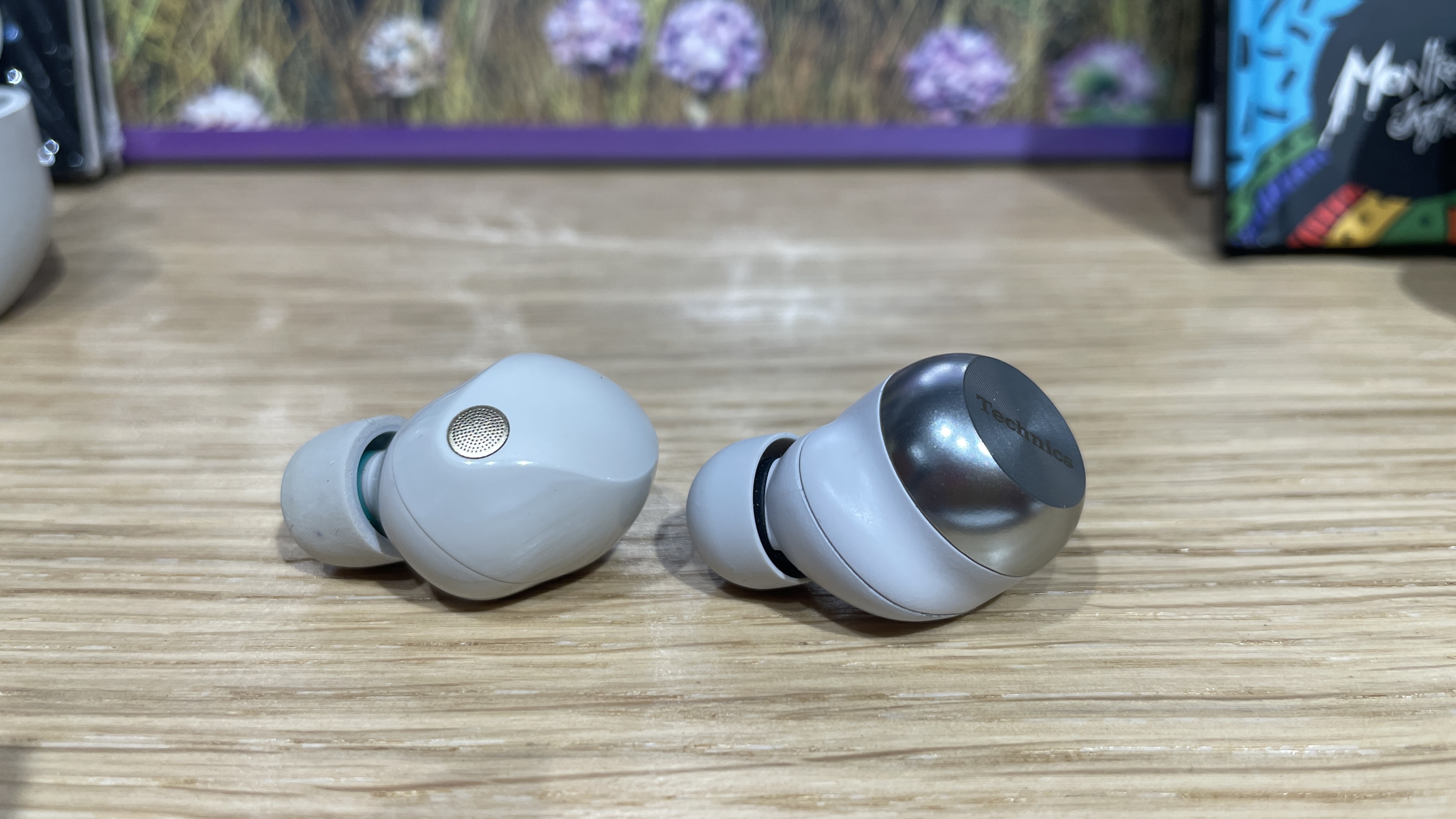
Sony and Technics have streamlined their premium earbuds to be lighter, smaller and more comfortable to wear than previous generations.
The XM5 buds are encased in a glossy-coated, premium-feeling plastic, and overall feel a little more luxurious than the AZ100. You get four eartips in the box (SS, S, M, L) and with their polyurethane material (which feels like a hybrid of silicone and memory foam), it can be tricky to get a good seal straightaway, but the XM5 are fairly secure once in. We'd like more eartip sizes or a grippier material, but you can employ the ear tip fit test using the Sound Connect app (previously called Headphones Connect) to double-check you've got the best fit.
The AZ100 don't quite have the premium feel of the XM5, but they do look smart with the shiny aluminium finish on the outer cap contrasting against the matte body. They come with five ear tips (SS, S, M, ML, L) and are far easier to get a comfortable, secure fit and seal straightaway. The AZ100 earbuds' body is more ergonomically shaped so it nestles in your concha better than the XM5. Both buds actually weigh the same at 5.9g each, but the way the weight is distributed across the body of the AZ100 buds compared with the XM5 (which feels chunkier) means the Technics feel more lightweight and comfortable to wear over time. There's no ear tip fit test in the Technics Audio Connect app, but we didn't miss it here.
Both are available in black or silver finishes with matching charging cases. Both cases are slim and pocketable, with the Technics' brushed metal case ever-so-slightly shorter than the Sonys, but the pebble-smooth case of the XM5 is smaller in width and feels more compact thanks to its curvy design. Be warned that the silver finish of the AZ100 case can get marked rather easily when placed in bags.
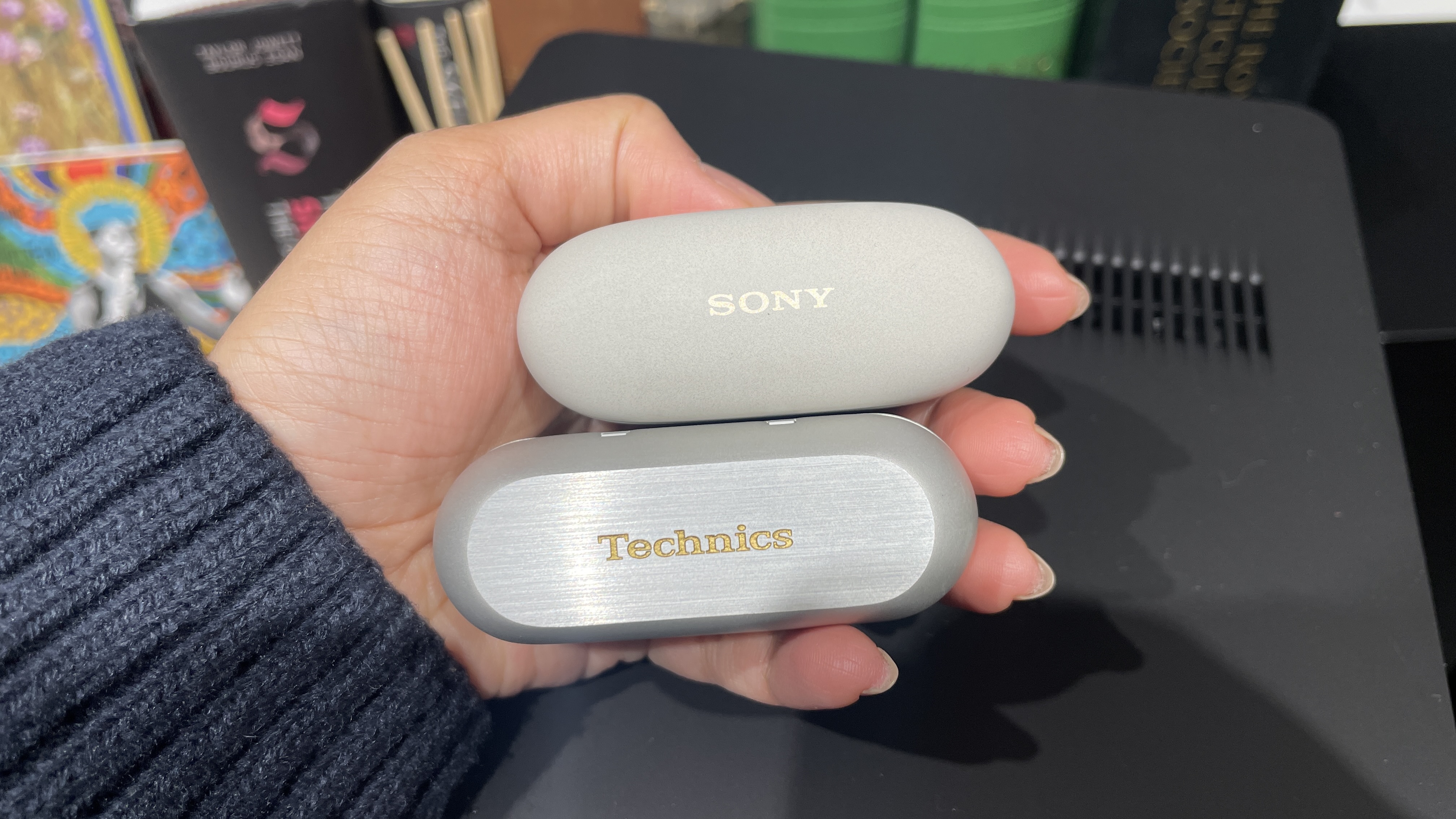
Both can be charged with USB-C and compatible wireless chargers, and our one small niggle is we wish the magnets on the Technics case – the ones that keep the buds in the case and the ones that keep the lid shut – was stronger so it feels more secure. You can also control both earbuds using the on-bud touch controls, with a series of single taps, multiple taps and long presses that let you adjust music playback, change noise modes and volume, accept (or refuse) calls and summon voice assistants. You can customise and assign these controls to a much greater degree on the Technics AZ100 than on the Sony XM5, which is very appealing to those who want to tailor the controls to their specific uses. The touch controls all work well, with only a small learning curve to get used to the various taps.
For their more comfortable, secure design across a wider variety of ears and more customisable controls, the Technics AZ100 are our preference here.
**Winner: Technics EAH-AZ100**
Technics EAH-AZ100 vs Sony WF-1000XM5: features
- Both earbuds feature flagship features and are easy to use
- Technics offers three-way Multipoint Bluetooth over Sony's two-way
- Both support Bluetooth 5.3 and high-quality LDAC codec
- Technics buds have longer battery life
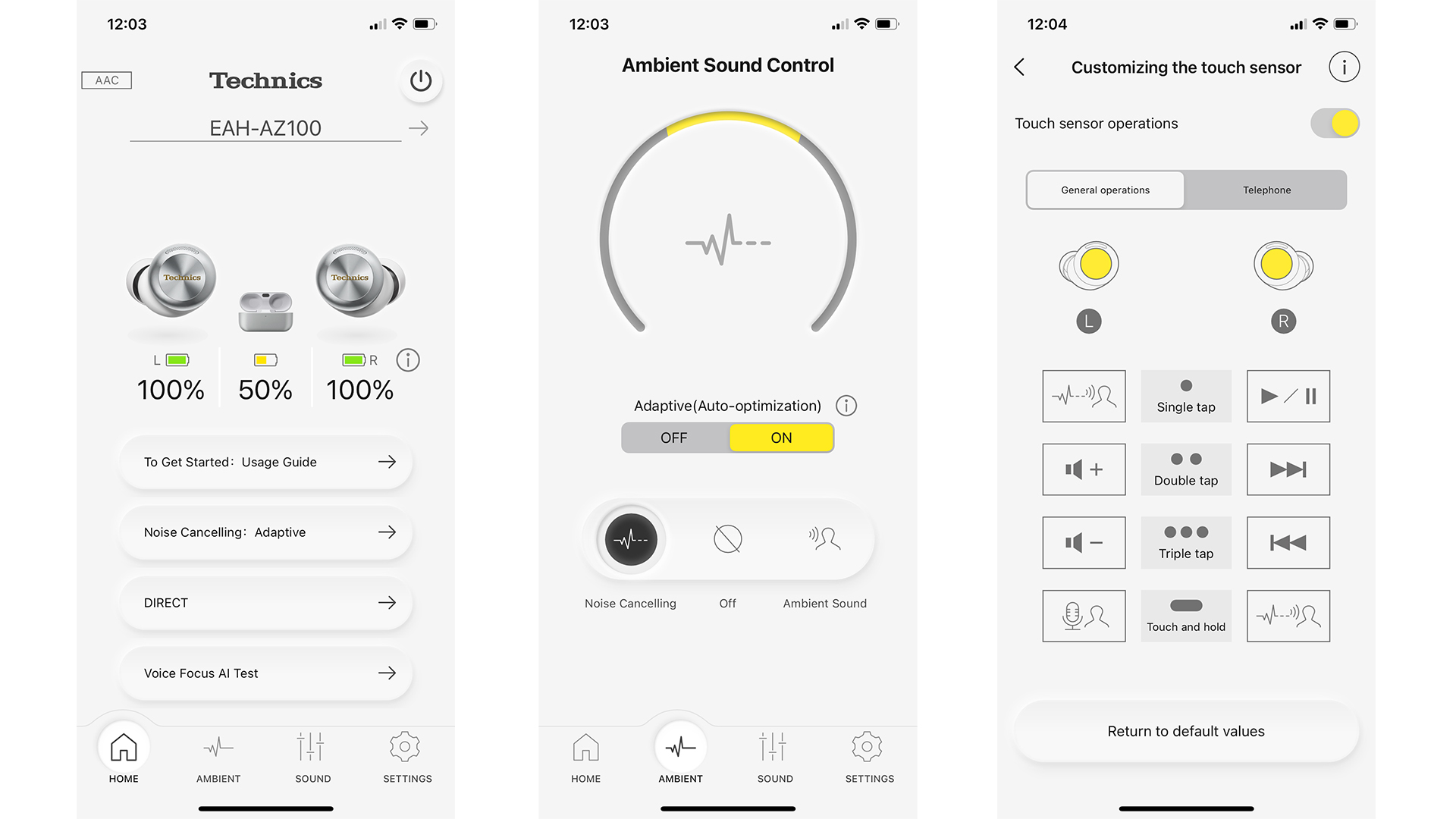
The Sony WF-1000XM5 and Technics EAH-AZ100 come with ample, cutting-edge features that we've come to expect from premium earbuds. The Technics are technically two years ahead of the XM5 now, so it's no surprise that it has certain advancements that are available now compared with the XM5.
The buds are well-matched on the whole, however. Bluetooth 5.3 is on board for both sets, and they support the standard AAC and SBC codecs alongside LE Audio/LC3, which allows for more efficient and lower latency transmission between supported devices. The AZ100 also supports the upcoming (but not yet widespread) Auracast transmission feature, which the Sony does not. Both offer swift and stable connections, too, although we found the Technics to be a smidge quicker and smoother every time.
When it comes to higher-quality codec support, both buds eschew Qualcomm's aptX options and instead offer the Sony-developed LDAC codec. This allows you to transmit 24-bit hi-res music at data rates of 990kbps - much higher than the standard codecs - from compatible products. When playing hi-res tracks from an LDAC-compatible source, such as the Sony NW-A306 or Astell & Kern SR35 players, both buds showcase a more solid, detailed and powerful sound.
You can even select which codec you want to use in the Technics app, while Sony additionally offers its own DSEE engine that upscales low-quality streams to higher quality.
Multipoint Bluetooth has increasingly become a feature we can't do without, where you can seamlessly switch between two connected devices as media plays from one or the other. This is especially useful if you're a multi-tasker who uses two devices – a laptop and a smartphone, for example – daily and in tandem for music, videos, calls and more. Technics ups the ante by offering three-way Multipoint Bluetooth – the only brand to do so at the moment – so you can seamlessly switch between three connected devices instead of the standard two. The feature works well with both earbuds, and you can further adjust how you want it to work in the AZ100's settings.
Features such as wear detection – which pauses music when you take an earbud out and resumes playing when the bud is placed back in your ear – and spatial audio support are present in both pairs. Sony XM5 supports its own 360 Reality Audio immersive audio format, which is available on Amazon Music Unlimited (but not on Tidal anymore), while Technics supports the more broadly available Dolby Atmos music format. We found the Technics' immersive effect to be subtler than most earbuds, especially when deploying the dynamic head tracking mode, which we rather like.
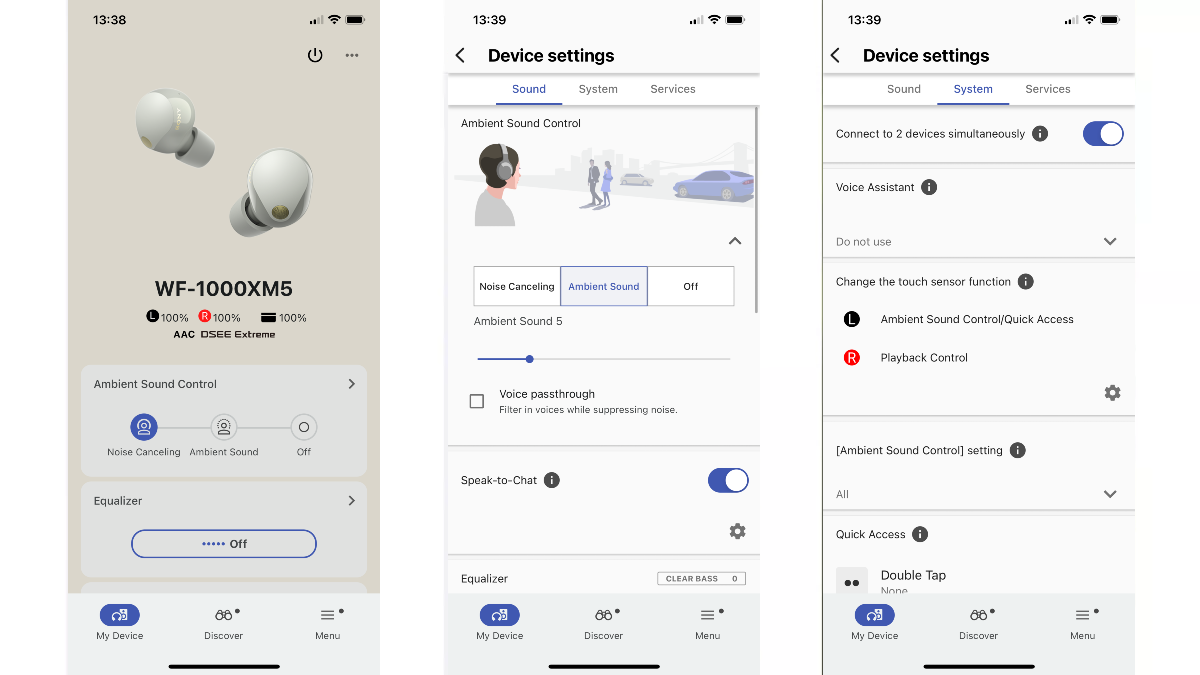
Sony's XM5 has some nifty features up its sleeve, like 'Speak-to-Chat', which detects when you're speaking and lowers the volume so you can have a quick conversation. It works intuitively when ordering a coffee or answering your colleague's question. Technics has its own spin on this conversation mode; there's no speech-detecting tech here, but you can assign a one-tap 'Attention' mode that focuses and amplifies voices only. It's not quite as natural as how Sony's version works, but the option is there for those who really want it. Sony has recently given their app a facelift and there is good scope to adjust the sound and noise-cancelling, while Technics goes one step further and offers a wealth of customisation options with clear explanations so you can tailor the AZ100 exactly to your needs.
It's a closely fought battle when it comes to features and a smooth experience, but the Technics AZ100 leap forward when it comes to battery life. The Sony XM5 offer six hours on a single charge from the buds, with 24 hours in total from the charging case (with ANC turned on). These were standard numbers expected from a premium pair (and are similar to Apple and Bose's flagship figures), but the newer Technics has pushed those figures forward. The AZ100 boast eight hours on a single charge (with ANC on) and 32 hours in total with the charging case. They certainly last long during our testing, and we reached for the Technics' charger less frequently than the Sonys’.
The Sonys’ features are well-executed, but for the extra options and greater battery life, the Technics edges ahead in this area.
**Winner: Technics EAH-AZ100**
Technics EAH-AZ100 vs Sony WF-1000XM5: ANC and call quality
- Both offer adjustable ANC, with Technics able to damp down more noise than the Sony
- On calls, voices sound more natural and warm through Sony XM5
- Background noise is eliminated to a greater degree through Technics AZ100

Technics and Sony offer full active noise-cancelling (ANC) with a particular focus on eliminating more low-frequency noise, a Transparency/Ambient mode that lets outside noise in so you are aware of your surroundings, and an adaptive mode that blends the two extremes and automatically adapts to your surroundings.
The Technics lets you dial up or down the ANC level (out of 100), while its new Adaptive mode adjusts levels in real-time to deliver the best ANC level for your fit and surroundings. We find this works well enough that we leave it in this mode by default. You can further fine-tune the amount of outside sound coming through in this profile, while the Transparency mode has two further options: a general one (Ambient) that lets all noise through, or the Attention mode that reduces background noise and amplifies voices. We found the latter to be rather unnatural as it sounds heavily processed, but train announcements can be harder to hear with the former.
Sony offers similar modes, but it doesn't let you adjust the level of full ANC. In the app, you can adjust how much ambient noise you want to hear, as well as a 'voice passthrough' mode that focuses on voices. There is an additional Adaptive Sound Control option on the XM5, which learns your noise preferences based on your daily activities and locations, and you can set different levels for when you're sitting indoors, when walking or on a noisy commute, as well as registering different locations, such as home or office. This is a deeper level of fine-tuning the ANC performance to your daily activities, and it is clever in use – although we do find Sony's standard ANC modes work just fine.
Both buds offer a good amount of noise-cancelling, with low-frequency noises such as the rumbles of train engines, the whirr of an air conditioner or exhaust fan and the general hum of traffic being pleasingly damped and dimmed when full ANC is activated. We find that the Technics shaves off just a bit more noise (especially low rumbles and droning sounds) around you compared with the Sony XM5. While Bose's QuietComfort Ultra Earbuds remain unmatched when it comes to eliminating noise around you and encasing you in a bubble of silence, we find there's less of that intense 'vacuum' effect on both the Sonys and Technics, which makes them a more comfortable, airy listen, especially if you'll be leaving ANC on at all times.
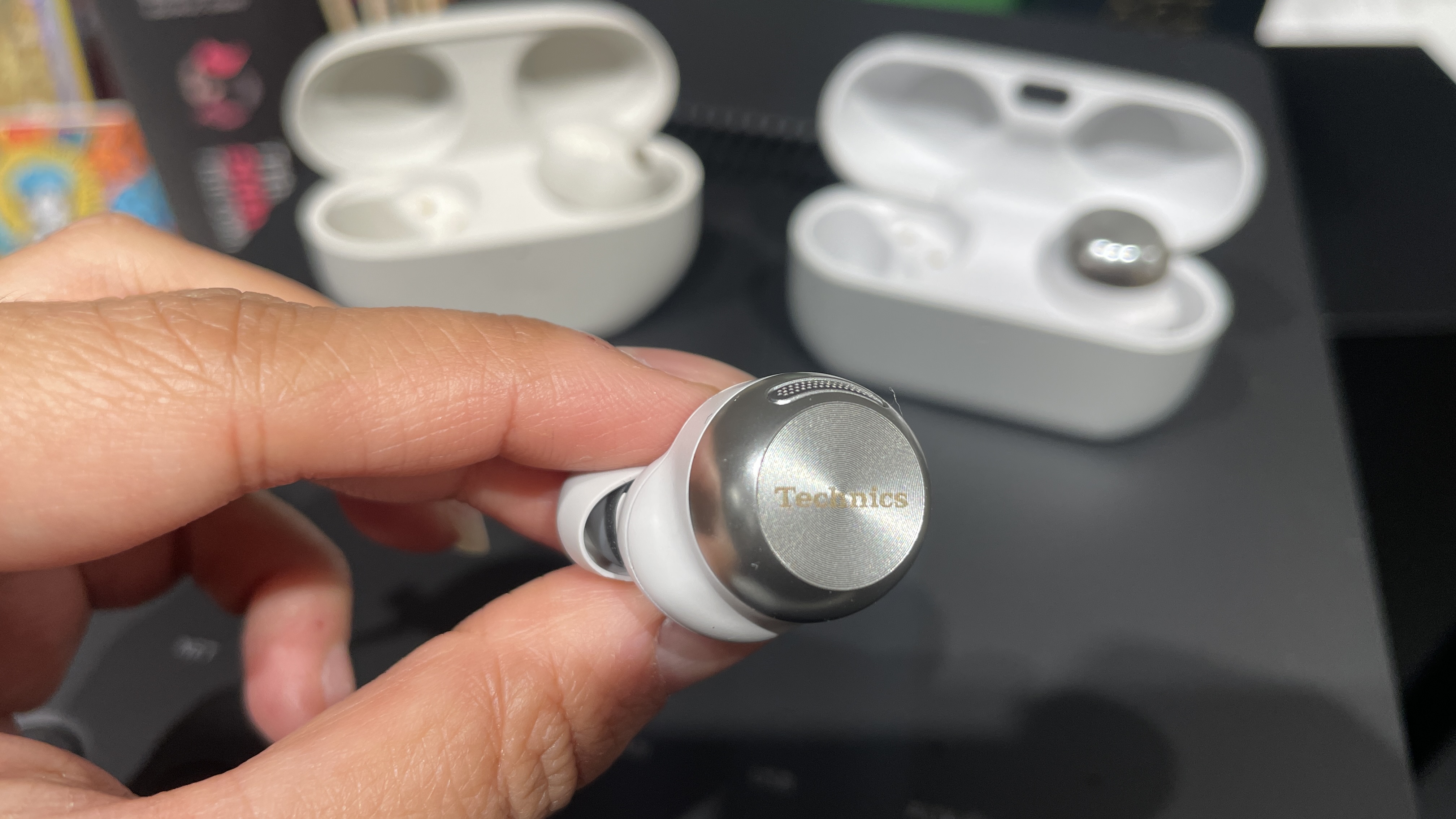
Call quality is another area that both Sony and Technics compete on, with each earbuds' mics, design and AI-based technology employed to make voices sound clearer, especially when you're in very noisy and windy areas. When using the Sony outdoors, general wind noise is mostly subdued, and we said in our review: "With wind blowing from multiple directions and speaking at normal conversation levels, our voice sounded detailed, clear and easy to follow which isn’t always the case with wireless earbuds."
On the Technics, turn on the Voice Focus AI feature and wind and traffic noises are dramatically eliminated. It's an impressive effect that leaves only your voice in focus, but we did find that voices can sound "rather unnatural with a hard edge, with the recipient on the other end even calling it ‘robotic’ at times" with this mode turned on. This Voice Focus AI feature works for both the caller and recipient too, which is a nice touch, and is useful when you really need it.
When taking phone or video calls indoors in quiet spaces, speech comes through clearly on both earbuds. Our voices sound very clear and with less background noise when using the Technics; you get more background noise coming through with the Sonys, but our voices sound a touch warmer and more natural. This one is down to your personal preference, but the Technics' stronger ANC levels and the option of the Voice Focus AI – even if we don't love how our voices get clipped when using it – get our vote here.
**Winner: Technics EAH-AZ100**
Technics EAH-AZ100 vs Sony WF-1000XM5: sound
- Technics offer greater clarity, detail, openness and even-handed sound
- Sonys entertain with greater rhythmic drive and dynamic punch

When we originally reviewed the Sony WF-1000XM5, we noted a sonic shift from their previous generation (the WF-1000XM4), favouring analytical precision, resolution and clarity over outright musicality and fun. It's a hugely accomplished performance, however, raising the bar for sound quality in wireless earbuds. We said in our original review: "There's an openness which we haven’t really heard from wireless earbuds at this level before and the definition and texture that shines through is quite exceptional."
We've found ourselves warming to the XM5's sonic character the more we spent time with them, and in the last year and a half since our first listen, the sound has evolved to become more full-sounding and even more entertaining, but it still continues to impress us in terms of detail, top-notch timing, superb rhythmic drive and punchy dynamics. Sony uses an 8.5mm driver (called Dynamic Driver X) which comprises two materials – one for high frequencies and one for lows – and has the benefit of reducing mechanical noise as the larger driver doesn't need to move as much as the previous, smaller drivers. The bass performance is controlled but with enough impact to satisfy, while orchestral pieces are organised and well-defined. They have the knack of getting right to the heart and message of a song, revealing nuances in vocals and textural depth of instruments, while the attitude and personality of the artist and song shine through.
The new Technics EAH-AZ100 earbuds take clarity, detail and openness to another level, even more so than on the XM5. The presentation is wider and more spacious, with more of that even-handed balance across the frequencies that we've come to expect from Technics earbuds. Orchestral works have ample space to flourish and display their subtle details, as do sweet-sounding and clear high frequencies, while basslines are grippier and pulled taut more than the previous generation, the EAH-AZ80. In fact, the AZ100 entertain us with a livelier and more dynamic performance than before, bringing the gap closer to the current class leaders while excelling in delivering outright detail and clarity. Inside each AZ100 earbud is a 10mm Magnetic Fluid Driver, which improves power handling and helps damp down any unwanted rocking motion of the diaphragm, allowing for greater low-end power and reducing distortion levels.
Next to the Technics AZ100, the Sony XM5 sound richer and fuller in the bass, but they still lead the way when it comes to agility, rhythm and punchier dynamics. We found that the XM5 continue to "appeal to those whose music collection relies on rhythmic drive and propulsive timing. The Technics get pretty close though, although we wouldn’t say no to greater momentum and more attitude for certain songs that demand it."
There's no denying that the Technics AZ100 are clearer, more detailed, even balanced and open-sounding, however we still find the Sony XM5's punchy, engaging sound to have its charms. This will come down to personal tastes, but the AZ100 have set a high bar for the new crop of premium earbuds.
**Winner: Technics EAH-AZ100**
Technics EAH-AZ100 vs Sony WF-1000XM5: verdict
This was a closely-fought battle, and we ended up spending hours ruminating over every feature and spending more time with both earbuds beyond our reviewing duration to ensure we compared the Sony and Technics flagships at every stage. There are many features on which both earbuds are competitive and are on par with each other, and which specific feature (as well as sonic signature) is more important to you will guide your buying choice.
Technics' new EAH-AZ100 are impressive, and we overall prefer their more comfortable, secure fit and longer battery life over the long-running Sony rivals, while their wonderfully balanced and impressively detailed, open and clear sound has won us over at this premium price range. If you are looking for new, cutting-edge wireless earbuds that sound a cut above the rest and have the cash to spend, we think you'll be more than happy with the Technics EAH-AZ100.
Sony's WF-1000XM5 are starting to show their age, but their sonic temperament is still so enjoyable that many of us would still recommend them as some of the best wireless earbuds around, especially at their new knockdown price. That you can get such excellent sound quality and advanced features for so little these days is astounding, and we still highly rate its dynamically engaging performance that delivers a song's feel and momentum so adeptly. In terms of sound-per-pound value, the XM5 are still a great buy, but the Technics AZ100 perform just a little better in nearly every area at this moment.
MORE:
Read the full Technics EAH-AZ100 review
And read our Sony WF-1000XM5 review
Best wireless earbuds: top pairs tested by our reviewers
Get the What Hi-Fi? Newsletter
The latest hi-fi, home cinema and tech news, reviews, buying advice and deals, direct to your inbox.

Kashfia is the Hi-Fi and Audio Editor of What Hi-Fi? and first joined the brand 13 years ago. During her time in the consumer tech industry, she has reviewed hundreds of products (including speakers, amplifiers, turntables and headphones), been to countless trade shows across the world and fallen in love with hi-fi kit much bigger than her. In her spare time, Kash can be found tending to an ever-growing houseplant collection and shooing her cat Jolene away from spinning records.
-
Ferdy Bossy Only you can make the right decision, everyone is unique, also with regard to their taste in sound reproduction. Connected the IEM to my DAC and for the first time heard reproduction similar to an electrostatic speaker. Be careful, they are not powered the same as headphones. Indeed not wireless, but the audio reproduction is unique. Maybe it would be wise to try it once.Reply -
SuperMarioY Sony greatly simplified the dilemma for me when they destroyed my 1000XM4 earbuds via their upgrade then refused to fix the problem. I will never again buy Sony product for as long as I am alive. Technics it is.Reply -
Ferdy Bossy Reply
Thanks for the warning, customer service is very important. Brands say nothing, my first CD player was a REVOX that brand makes junk, after the warranty period it did not work anymore. Didn't have this repaired, just spent more than a thousand guilders on parts!SuperMarioY said:Sony greatly simplified the dilemma for me when they destroyed my 1000XM4 earbuds via their upgrade then refused to fix the problem. I will never again buy Sony product for as long as I am alive. Technics it is. -
Webz I have been a LONG TIME user of the 1000XM3's. They have been my daily commute earbuds and performed admirably. I switched to the AZ100's and it's a night-and-day improvement over the Sony's. Bass is tighter and more impactful. Mids are less muddy. It's a noticeable improvement. The Technics compare very closely to my home music headphones (B&W px7 s2e). The Technics are also a lot more comfortable and I have had far fewer ear drop-outs compared to the oddly balanced Sony's.Reply
